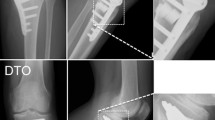Abstract
Purpose
To investigate the effects of early patellar dislocation on the tibial tubercle location.
Methods
Sixty knees from 30 healthy 1-month-old New Zealand white rabbits were randomly divided into two groups of 30 knees each. Group A (control group) comprised the left knees, which underwent no surgical procedures. Group B comprised the right knees, which underwent patellar dislocation surgery. Computed tomography (flexion 0°) was performed preoperatively and 6 months post-operatively. Measurements included the tibial tuberosity–trochlear groove distance (TT–TG) and tibial tubercle lateralization.
Results
No significant difference in the TT–TG or tibial tubercle lateralization was found between the two groups preoperatively. Six months post-operatively, however, the mean TT–TG in Group A (no patellar dislocation) and Group B (patellar dislocation) was 1.0 ± 0.4 and 3.0 ± 0.7 mm, respectively (p < 0.05). The mean tibial tubercle lateralization also showed a significant difference between Groups A and B at 6 months post-operatively (0.5 ± 0.1 and 0.6 ± 0.0, respectively; p < 0.05).
Conclusions
Early patellar dislocation can lead to tibial tubercle lateralization and an increased TT–TG. Clinically, early intervention for adolescent patients with patellar dislocation will be important.
Level of evidence
Prospective comparative study, Level II.


Similar content being viewed by others
References
Atkin DM, Fithian DC, Marangi KS et al (2000) Characteristics of patients with primary acute lateral patellar dislocation and their recovery within the first 6 months of injury. Am J Sports Med 28:472–479
Balcarek P, Jung K, Ammon J et al (2010) Anatomy of lateral patellar instability: trochlear dysplasia and tibial tubercle–trochlear groove distance is more pronounced in women who dislocate the patella. Am J Sports Med 38:2320–2327
Beasley LS, Vidal AF (2004) Traumatic patellar dislocation in children and adolescents: treatment update and literature review. Curr Opin Pediatr 16:29–36
Berruto M, Ferrua P, Carimati G et al (2013) Patellofemoral instability: classification and imaging. Joints 1:7–14
Goutallier D, Bernageau J, Lecudonnec B (1978) The measurement of the tibial tuberosity. Patella groove distanced technique and results (author’s transl). Rev Chir Orthop Reparatrice Appar Mot 64:423–428
Grelsamer RP, Dejour D, Gould J (2008) The pathophysiology of patellofemoral arthritis. Orthop Clin N Am 39:269–274
Heidenreich MJ, Camp CL, Dahm DL et al (2015) The contribution of the tibial tubercle to patellar instability: analysis of tibial tubercle-trochlear groove (TT–TG) and tibial tubercle–posterior cruciate ligament (TT–PCL) distances. Knee Surg Sports Traumatol Arthrosc. doi:10.1007/s00167-015-3715-4
Huri G, Atay OA, Ergen B et al (2012) Development of femoral trochlear groove in growing rabbit after patellar instability. Knee Surg Sports Traumatol Arthrosc 20:232–238
Kaymaz B, Atay OA, Ergen FB et al (2013) Development of the femoral trochlear groove in rabbits with patellar malposition. Knee Surg Sports Traumatol Arthrosc 21:1841–1848
Koeter S, Diks MJ, Anderson PG et al (2007) A modified tibial tubercle osteotomy for patellar maltracking: results at two years. J Bone Joint Surg Br 89:180–185
Koeter S, Horstmann WG, Wagenaar FC et al (2007) A new CT scan method for measuring the tibial tubercle trochlear groove distance in patellar instability. Knee 14:128–132
Li W, Wang Q, Wang F et al (2013) Femoral trochlear dysplasia after patellar dislocation in rabbits. Knee 20:485–489
Magnussen RA, De Simone V, Lustig S et al (2014) Treatment of patella alta in patients with episodic patellar dislocation: a systematic review. Knee Surg Sports Traumatol Arthrosc 22:2545–2550
Nietosvaara Y, Aalto K, Kallio PE (1994) Acute patellar dislocation in children: incidence and associated osteochondral fractures. J Pediatr Orthop 14:513–515
Omeroglu H, Bicimoglu A, Agus H et al (2007) Acetabular development in developmental dysplasia of the hip. A radiographic study in anatomically reduced and uncomplicated hips. Bull NYU Hosp Jt Dis 65:276–279
Petri M, Ettinger M, Stuebig T et al (2015) Current concepts for patellar dislocation. Arch Trauma Res 4:e29301
Schoettle PB, Zanetti M, Seifert B et al (2006) The tibial tuberosity–trochlear groove distance; a comparative study between CT and MRI scanning. Knee 13:26–31
Smith TO, Donell S, Song F et al. (2015) Surgical versus non-surgical interventions for treating patellar dislocation. Cochrane Database Syst Rev (2):CD008106. doi:10.1002/14651858.CD008106.pub3
Tanaka MJ, Elias JJ, Williams AA et al (2015) Correlation between changes in tibial tuberosity–trochlear groove distance and patellar position during active knee extension on dynamic kinematic computed tomographic imaging. Arthrosc J Arthrosc Related Surg 31:1748–1755
Tensho K, Akaoka Y, Shimodaira H et al (2015) What components comprise the measurement of the tibial tuberosity–trochlear groove distance in a patellar dislocation population? J Bone Joint Surg Am 97:1441–1448
Theodorou SD, Gerostathopoulos N (1989) Congenital dislocation of the hip. Observations on the early diagnosis and results of treatment with an abduction brace in infants two to nine months of age in Greece. Clin Orthop Relat Res 246:22–29
Wang S, Ji G, Yang X et al (2016) Femoral trochlear groove development after patellar subluxation and early reduction in growing rabbits. Knee Surg Sports Traumatol Arthrosc 24:247–253
Author information
Authors and Affiliations
Corresponding author
Ethics declarations
Conflict of interest
All authors declare that they have no conflict of interest.
Funding
This study was funded by the National Natural Science Foundation of China (Grant Number: 81371910).
Ethical approval
All procedures performed in studies involving animals were in accordance with the ethical standards of the institution or practice at which the studies were conducted.
Informed consent
Informed consent was obtained from all individual participants included in the study.
Electronic supplementary material
Below is the link to the electronic supplementary material.
Rights and permissions
About this article
Cite this article
Niu, Y., Cao, P., Liu, C. et al. Early patellar dislocation can lead to tibial tubercle lateralization in rabbits. Knee Surg Sports Traumatol Arthrosc 26, 2602–2606 (2018). https://doi.org/10.1007/s00167-017-4541-7
Received:
Accepted:
Published:
Issue Date:
DOI: https://doi.org/10.1007/s00167-017-4541-7




